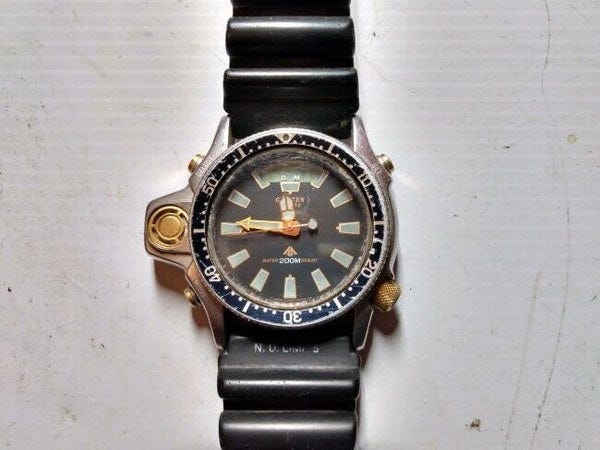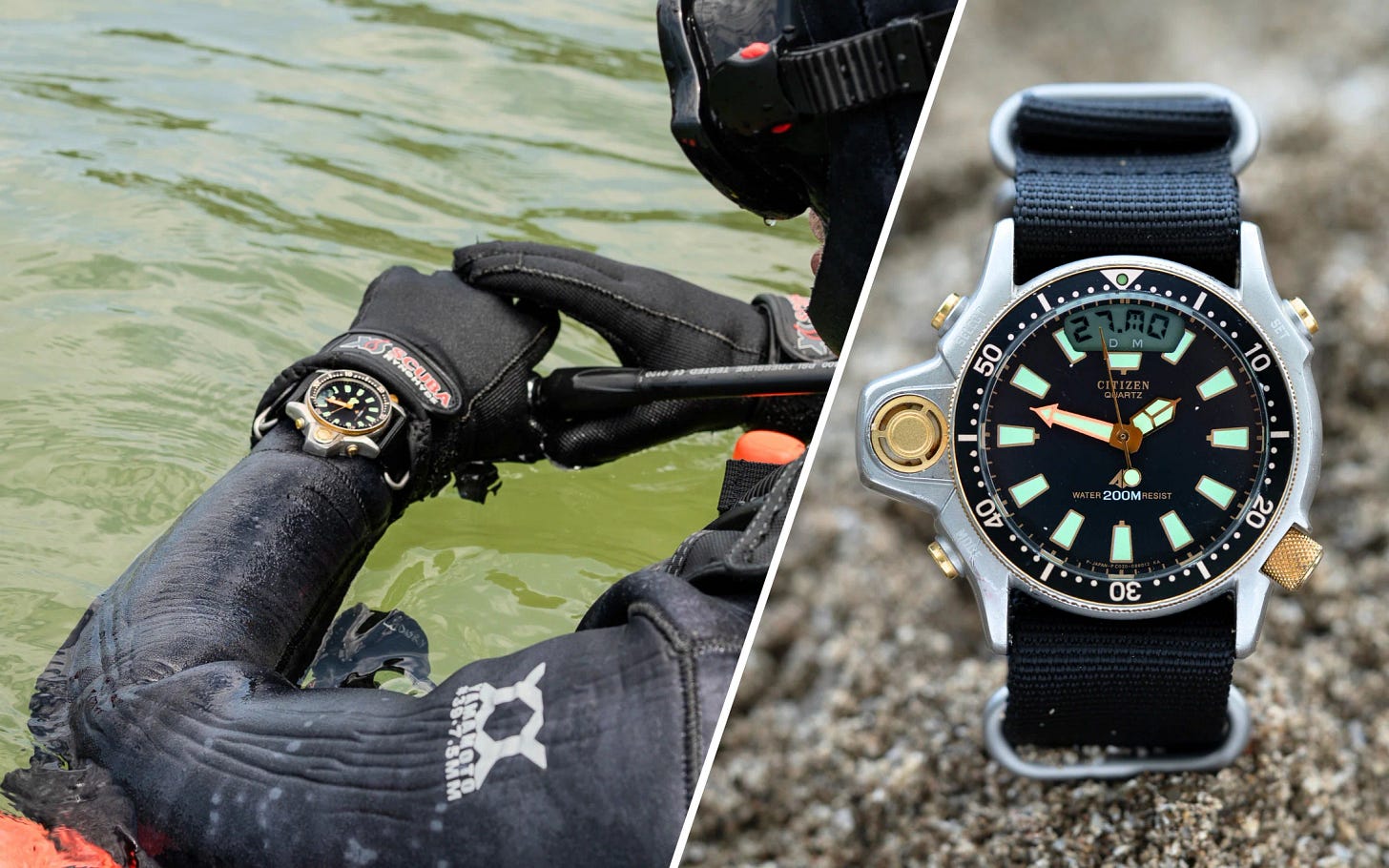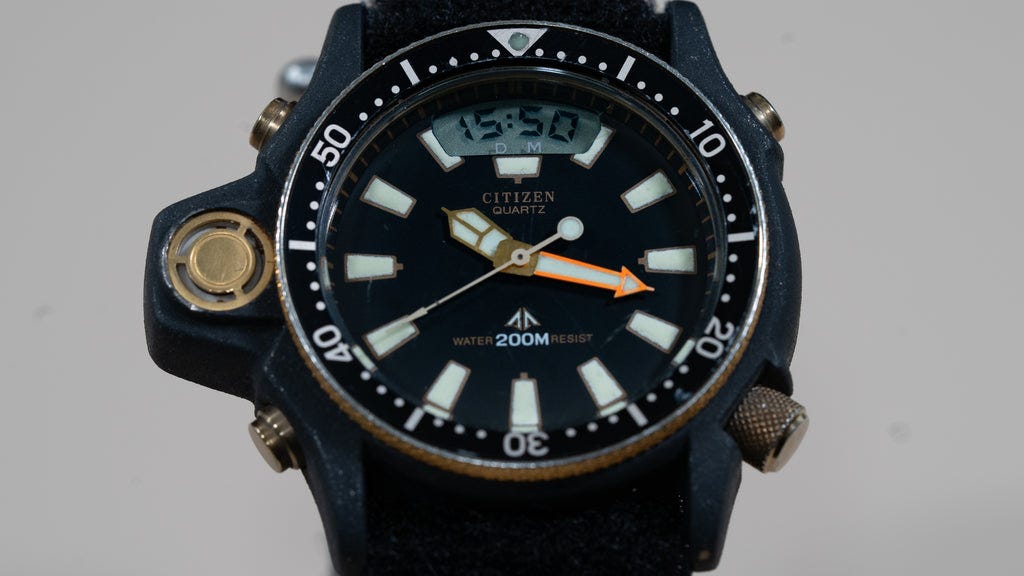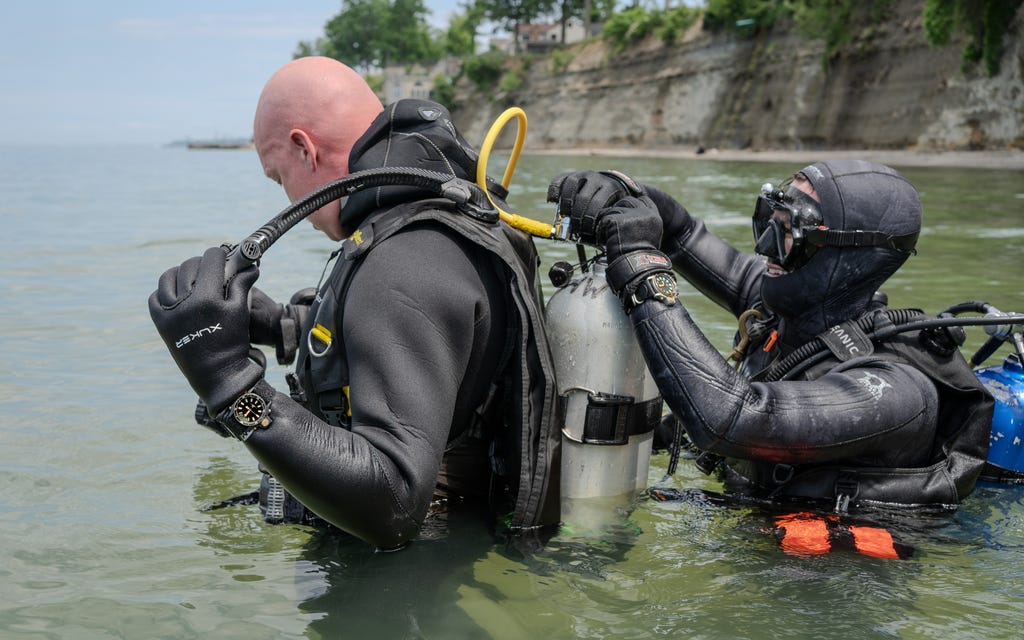We’ve all heard it. Reddit threads are rife with second-hand testimonials from someone’s third cousin who absolutely may have been a watchmaker and a divemaster, categorically confirming it’s impossible to go diving with a vintage watch. Like a carton of milk or a piece of fruit, the dive watch has a shelf life that, once exceeded, renders the former undersea tool all but relegated to a life in the dry. But how true is this, really? As long as it’s been serviced, it’s good to go, right, or is it more nuanced than that? Are older dive watches truly incapable of returning to their former undersea glory or are watch enthusiasts simply too afraid to give their old Snowflake Submariners or Seiko 6309s a second chance under the surface?
In this edition of the Dive Log, I enlist the help of a couple of dive buddies as well as a pair of older Citizen Aqualand dive watches—my own recently acquired C023 and a friend’s extremely rare PVD titanium C029—to see if these old dogs can still hunt. Along with telling the tale of one of the all-time attainable dive watch legends and sharing our modest diving exploits with the watches, we’ll also address the often-asked question of whether or not diving with a vintage watch is a fool’s game or an overblown non-issue. But before tackling that burning issue, we must discuss a watch: the Citizen Aqualand.
The Birth Of A Legend
Born in 1985, the Citizen Aqualand was the world’s first dive watch integrating an electronic depth gauge made possible by a protruding sensor on the case’s nine o’clock side. Providing the diver with a constant depth reading, depth alarm, dive time, and a dive log, the Aqualand couldn’t be called a diving computer—the advent of which was soon to change the role of dive watches forever—but was a step in that direction. Proving rugged and capable, the Aqualand took off with divers from the recreational, commercial, and military diving communities, even becoming the issue watch of choice for Royal Australian Navy Clearance Divers in the 80s and 90s. We do some watch spotting over on our Instagram, and vintage Aqualands are commonly spotted on Navy SEALs, USAF Pararescuemen, US Navy Divers, and other international forces.

Because the Aqualand was relatively inexpensive and earned a good reputation, the standard stainless steel C022 and the two-tone C023 were widely sold in dive shops and jewelry stores around the world. My C023 was produced in 1990, making the watch 34 years young on the day of our dive. Unlike other legendary dive watches from the luxury tier, vintage examples of the old Aqualands can still be had cheaply, which makes them a fun vintage buy, though many need some tender love and care. More on that later.
The very rare range-topping C029 was, in contrast to its steel cousins, housed in a PVD-coated titanium case with gold accents. Seldom seen and highly desirable, the C029 was famously featured in 1988’s The Big Blue, a Luc Besson film about freediving in which Enzo Molinari, played by Jean Reno, prominently wears the chunky titanium Citizen. Unlike the steel variants, the C029 is extremely rare. When my buddy Kelly recently picked up a 1992 C029, we knew the only way to honor the watches was with a dive. We hastily constructed a plan for a Lake Erie shore dive and invited our other buddies including Jacob, a vintage diving enthusiast and frequent contributor to this Submersible Wrist, and Devin Pennypacker, our good friend and a talented photographer. But speaking of vintage equipment, our Aqualands are from 1990 and 1992, making them 34 and 32 years old, once again raising the question: is it OK to dive with older watches?
Capable Watchmakers, Pressure-Testing, & Common Sense
As we alluded to above, diving with a vintage watch—and we’ll call anything over 20 years old “vintage” for this discussion—comes with inherent risks. Compared to a new watch, the probability of having an issue with water ingress in a diving scenario can be higher. However, it’s important to remember that dive watches were designed to be diving equipment, and like virtually all quality diving equipment, watches intended for diving were and are designed to be serviceable. If you want to go diving with a vintage dive watch and aren’t sure when it was last serviced or if it was ever serviced, step one is locating a competent watchmaker who is also familiar with dive watches, even going so far as to ask whether they work on your particular model. This probably not going to be the kiosk at the mall that changes watch batteries.
I compare diving a vintage watch to driving a vintage car. Is the likelihood of having a mechanical issue higher with a vintage car? Yes. Is it therefore important to find the right shop or mechanic who specializes in dealing with your particular machine? Also yes. The same is true with watches. There are a lot of “watchmakers” out there but very few who understand the concept of preparing an older dive watch for a return to the sea. In addition, it’s also important your watchmaker has access to the correct parts for your watch. That sounds obvious, but we’ll talk about common sense in a moment. In short, ask your watchmaker detailed questions, look for reviews or references, and ensure they can handle your particular watch. That’s step one.

Step two is pressure testing, which is part of servicing, but also a capability not every watchmaker has. To adequately pressure test a dive watch, a watchmaker must own expensive specialized equipment capable of simulating your watch’s depth rating, or at the very least a lot more water resistance than you’re going to need. These older Aqualands are rated to 200 meters. That means I would ideally work with a watchmaker who can pressure test to these depths. If they can’t, I would also be comfortable with less, say 100 meters, if I trust the watchmaker and know I’m not going any deeper, which I’m not. In the vast majority of cases, if your 200-meter watch has been tested to 100 meters, you’re going to be good to go. Keep in mind that pressure testing for a watch that goes diving a lot needs to happen a lot more frequently than servicing the movement, as much as once or even twice per year for people who dive regularly. Once you find the right watchmaker, this process should be easy and cheap.

Third, you’re going to need some common sense. If you know the screw-down crown on your vintage dive watch doesn’t screw down very well or suspect your most recent service was done by someone who uses gaskets that are almost the certainly maybe the right size but they aren’t 100% sure, then you’re going to want to do the right thing and preserve your treasured timepiece. In addition, if your vintage Rolex 1665 “Great White” Sea-Dweller is worth $20k and you can’t remember when it was last pressure tested, I would argue the risk is not worth the Instagram photo. In most cases in 2024, you aren’t using your dive watch to time your dive or as direct life support equipment. I’m a major proponent of diving your dive watches whether they’re new or old as a backup to more modern tech, but it’s important to bring your common sense along for the ride. Step three, check. Let’s go diving.
Diving The Great Lakes With Vintage Citizen Aqualands
Speaking to our particular watches and our adherence to the above-listed guidelines, my C023 was serviced within the last year or maybe two by Citizen itself, meaning I had a great deal of confidence everything including the pressure test was carried out according to spec. Kelly’s C029 was also recently refurbished, in this case by Jack Alexyon of IWW, a legend in the vintage tool watch game that you should know if you don’t already. That said, we splashed with a high degree of confidence in our watches and without regard for their age. Given our shallow shore diving profile, I didn’t bring a diving computer. Jacob wore a modern Nivada Grenchen Chronomaster Aviator Sea Diver that was, despite its vintage looks, new enough—and much newer than his life support equipment—meaning he also hit the water without concern at least for his watch.
One of the best parts about shore diving is convenience. This particular beach was about a two-minute drive from my house and complete with a parking lot where we donned our gear. Not many go diving in these parts, and we received no shortage of quizzical looks from passersby as we walked across Lake Road and down the stairs to the beach. After some fiddling, we walked into the surprisingly warm and clear waters of the fourth-largest Great Lake. With a shallow sloping bottom contour, we had to fin a couple of hundred yards from shore to find water deeper than 10 feet. Once there, we attempted to descend only to learn that we were underweighted. A quick swim back to the beach and we filled our pockets with nature’s dive weights (rocks) and gave it another shot.
Once on bottom, we were greeted with awesome visibility by Great Lakes standards, as much as 15-20 feet in certain spots. The bottom was mostly rocks mixed with, driftwood, old bricks, and other building materials from Cleveland’s industrial past. Compared to many of my Great Lakes diving experiences, the water was also warm considering we never got deep enough to find the thermocline. Swapping the Aqualand into dive mode by pressing the lower left pusher a few times, the watch becomes even more of a diving tool, accurately reading our depths down to the bone-crushing 10 or so feet we experienced at the pinnacle of our dive.
At these depths, an 80-cubic-foot tank lasts a very long time, and we ambled underwater over the rocks and bricks until we were well and truly ready for a beer, surfacing and reversing our surface swim for another long walk back to our cars. Just as they’ve done for the past 30 years or so, our watches performed flawlessly, a product of good design and the proper maintenance any good tool deserves. Compared to many of the dives I’ve been lucky enough to do in more coastal locations, the actual diving portion of this one was nothing special. What was special was grabbing a couple of friends and some legendary dive watches and reminding ourselves that not every underwater adventure has to start and end with plane tickets. If there’s a reasonably safe body of water near you and you’ve always wondered what it would look like from beneath the surface, my advice is to find a dive buddy or two and try it out.
And, If your dive watch is older or even vintage, don’t let that stop you, just remember to get the thing pressure tested.
If you enjoyed this article, please be sure to follow us on Instagram and check out our website for Submersible Wrist gear and more content.
Thanks to Devin Pennypacker (@devin_pennypacker) for the great photos in this edition of the Dive Log.












